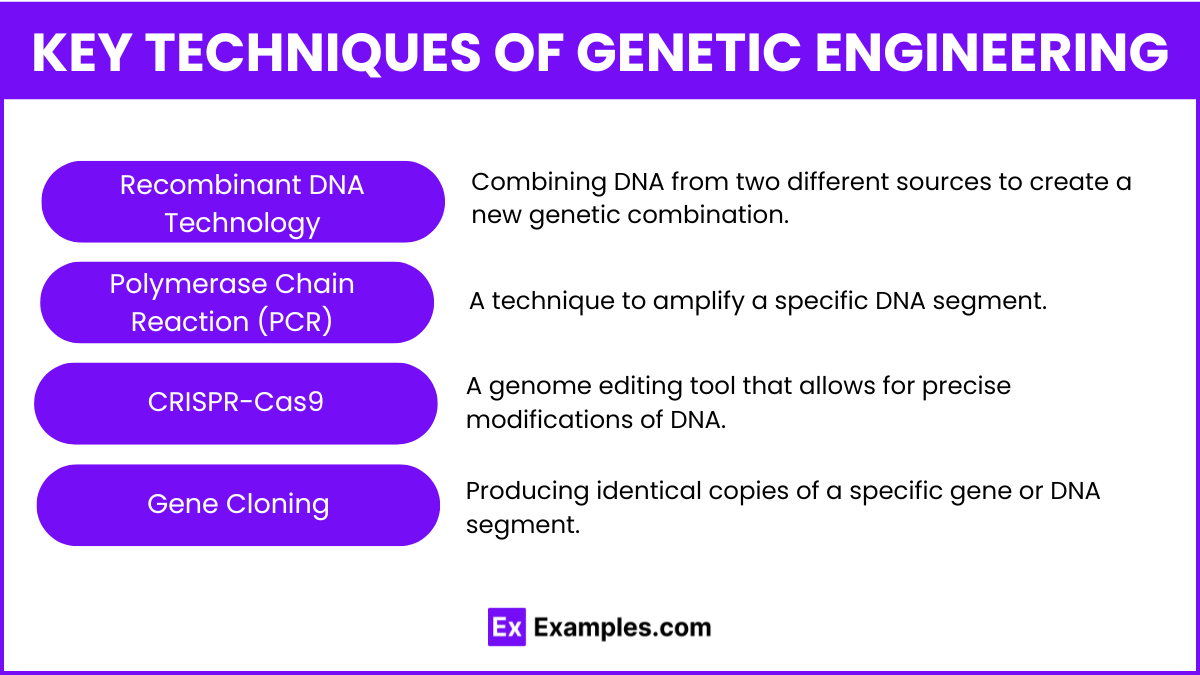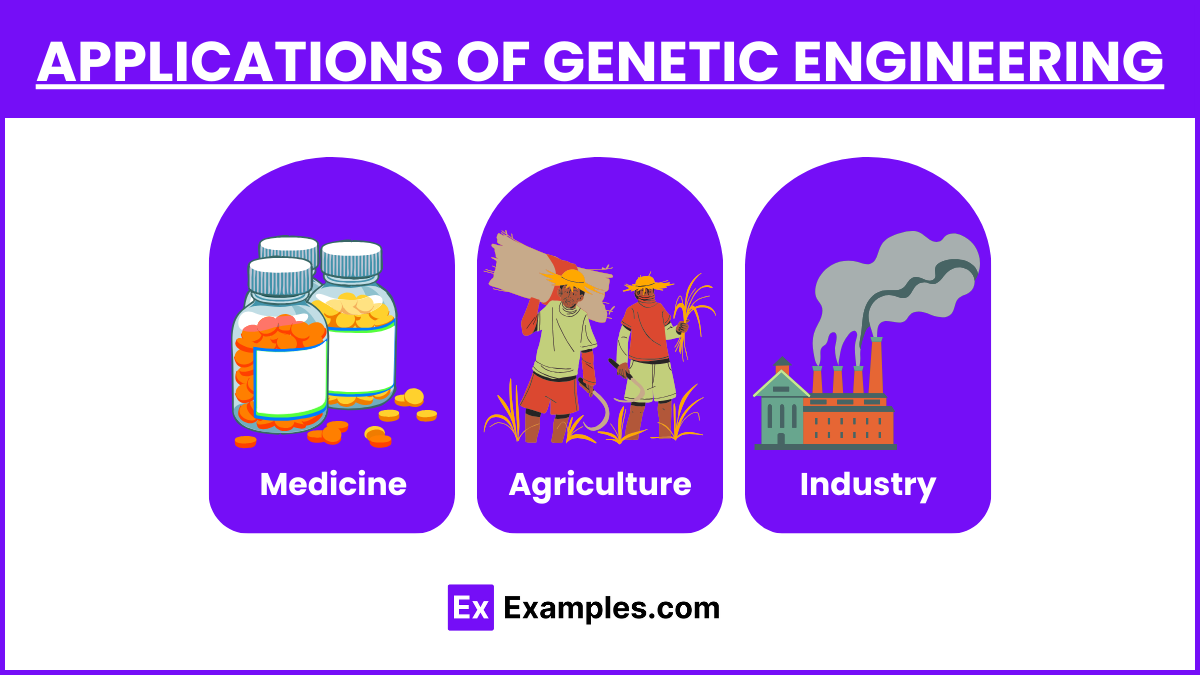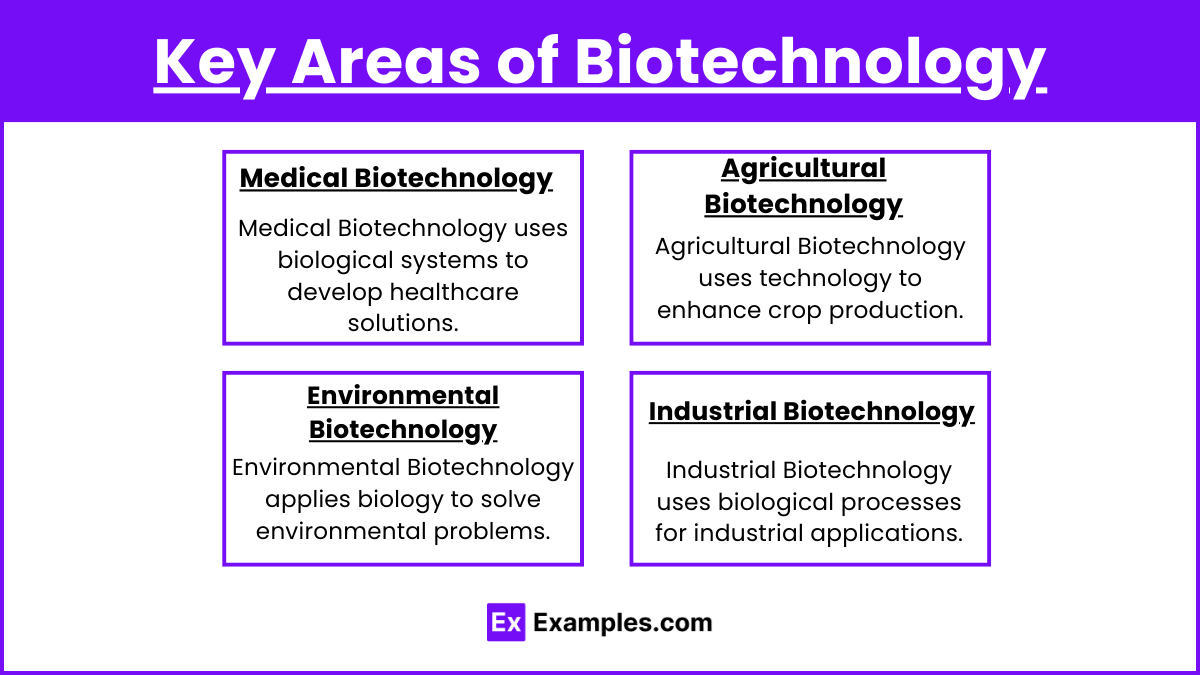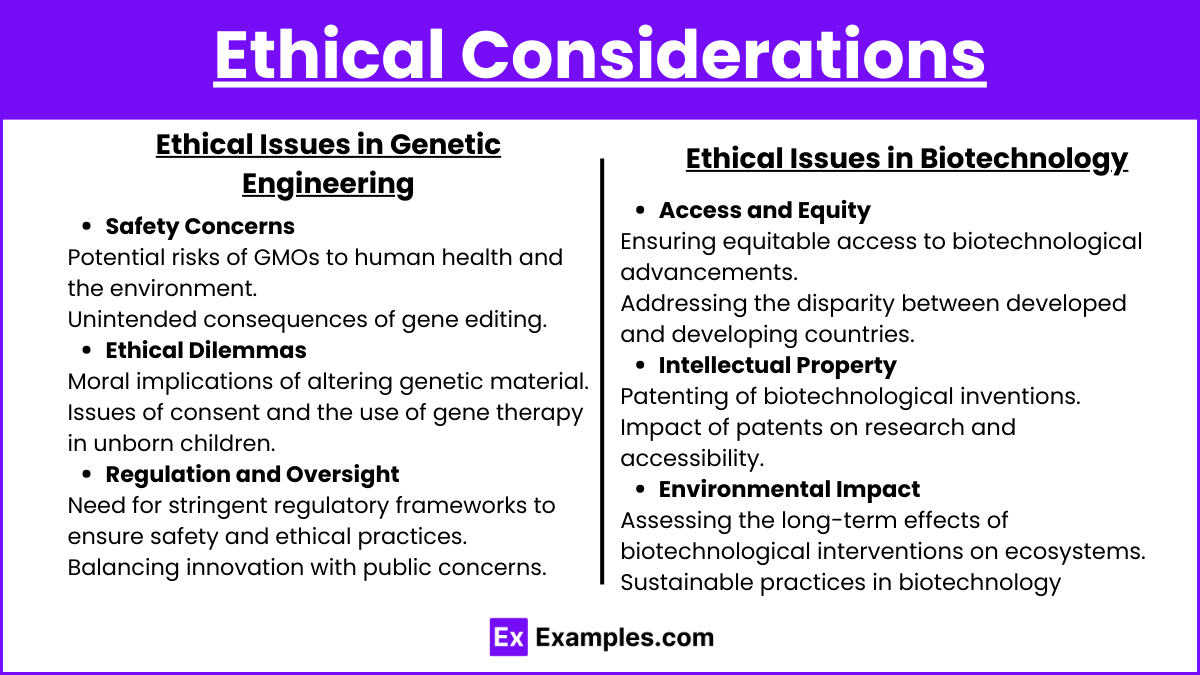In AP Biology, understanding genetic engineering and biotechnology is crucial as these fields involve manipulating organisms’ genetic material to develop new technologies and products. Genetic engineering directly modifies DNA to alter traits, while biotechnology applies these modifications for advancements in medicine, agriculture, and industry. These innovations drive significant progress, offering solutions for complex biological challenges and ethical considerations.
Learning Objectives
Understand the principles and applications of genetic engineering and biotechnology. Develop skills to manipulate DNA and other genetic materials. Gain proficiency in using biotechnological tools and techniques. Analyze the ethical, legal, and social implications of genetic modifications. Apply knowledge to solve real-world problems in medicine, agriculture, and industry. Conduct experiments to explore gene editing, cloning, and molecular diagnostics. Interpret scientific data and research findings. Communicate complex biotechnological concepts effectively. Foster critical thinking and innovation in genetic engineering advancements.
Genetic Engineering
Definition
- Genetic Engineering: The direct manipulation of an organism’s genes using biotechnology.
Key Techniques

- Recombinant DNA Technology
- Definition: Combining DNA from two different sources to create a new genetic combination.
- Steps:
- Isolation of DNA: Extracting DNA from the donor organism.
- Cutting DNA: Using restriction enzymes to cut DNA at specific sequences.
- Ligation: Joining DNA fragments using DNA ligase.
- Transformation: Introducing recombinant DNA into a host organism.
- Screening: Identifying cells that have successfully incorporated the recombinant DNA.
- Polymerase Chain Reaction (PCR)
- Definition: A technique to amplify a specific DNA segment.
- Steps:
- Denaturation: Heating the DNA to separate strands.
- Annealing: Cooling to allow primers to attach to the target DNA sequence.
- Extension: DNA polymerase extends the primers to form a new DNA strand.
- CRISPR-Cas9
- Definition: A genome editing tool that allows for precise modifications of DNA.
- Components:
- Cas9 Enzyme: Cuts the DNA at a specific location.
- Guide RNA (gRNA): Directs Cas9 to the target DNA sequence.
- Applications: Gene knockouts, insertions, and corrections.
- Gene Cloning
- Definition: Producing identical copies of a specific gene or DNA segment.
- Steps:
- Insertion of DNA into a vector: Often a plasmid or a virus.
- Transformation of host cells: Usually bacteria or yeast.
- Selection and screening: Identifying cells that contain the cloned gene.
Applications of Genetic Engineering

Medicine
- Gene Therapy
- Definition: Treating or preventing diseases by inserting, altering, or removing genes within a patient’s cells.
- Examples: Treatment of genetic disorders like cystic fibrosis and hemophilia.
- Production of Insulin
- Process: Inserting the human insulin gene into bacteria, which then produce insulin used to treat diabetes.
- Vaccines
- Recombinant Vaccines: Using genetically engineered organisms to produce antigens that trigger an immune response.
Agriculture
- Genetically Modified Organisms (GMOs)
- Definition: Organisms whose genetic material has been altered using genetic engineering techniques.
- Examples: Bt corn (insect-resistant), Roundup Ready soybeans (herbicide-resistant).
- Enhanced Nutritional Content
- Golden Rice: Rice engineered to produce beta-carotene, a precursor to vitamin A.
Industry
- Biofuels
- Definition: Fuels produced from living organisms or their metabolic by-products.
- Examples: Ethanol produced from genetically engineered yeast.
- Bioremediation
- Definition: Using organisms to remove or neutralize contaminants from the environment.
- Examples: Bacteria engineered to degrade oil spills.
Biotechnology
Definition
- Biotechnology: The use of living systems and organisms to develop or make useful products.
Key Areas of Biotechnology

- Medical Biotechnology
- Pharmaceuticals: Production of drugs and vaccines.
- Diagnostics: Development of tests and devices to detect diseases.
- Agricultural Biotechnology
- Crop Improvement: Developing crops with improved yield, pest resistance, and nutritional value.
- Environmental Biotechnology
- Waste Treatment: Using microorganisms to treat industrial and municipal waste.
- Pollution Control: Developing methods to monitor and reduce environmental pollutants.
- Industrial Biotechnology
- Enzyme Production: Using microorganisms to produce enzymes for industrial processes.
- Bioplastics: Developing biodegradable plastics from biological materials.
Ethical Considerations

Ethical Issues in Genetic Engineering
- Safety Concerns
- Potential risks of GMOs to human health and the environment.
- Unintended consequences of gene editing.
- Ethical Dilemmas
- Moral implications of altering genetic material.
- Issues of consent and the use of gene therapy in unborn children.
- Regulation and Oversight
- Need for stringent regulatory frameworks to ensure safety and ethical practices.
- Balancing innovation with public concerns.
Ethical Issues in Biotechnology
- Access and Equity
- Ensuring equitable access to biotechnological advancements.
- Addressing the disparity between developed and developing countries.
- Intellectual Property
- Patenting of biotechnological inventions.
- Impact of patents on research and accessibility.
- Environmental Impact
- Assessing the long-term effects of biotechnological interventions on ecosystems.
- Sustainable practices in biotechnology
Examples
Example 1: CRISPR-Cas9 in Gene Editing
- Scenario: Using CRISPR-Cas9 to correct a mutation causing cystic fibrosis.
- Process: Guide RNA directs Cas9 to the mutant gene, Cas9 cuts the DNA, and the correct sequence is inserted.
- Importance: Demonstrates a precise method for gene correction.
Example 2: Production of Insulin
- Scenario: Producing human insulin in bacteria for diabetes treatment.
- Process: Human insulin gene is inserted into a plasmid, transformed into bacteria, and bacteria produce insulin.
- Importance: Shows how genetic engineering can produce essential medications.
Example 3: Bt-corn
- Scenario: Engineering corn to express a bacterial gene that produces a toxin harmful to pests.
- Process: Bt gene is inserted into corn DNA, corn produces Bt toxin, and pests are deterred.
- Importance: Illustrates genetic engineering in agriculture for pest resistance.
Example 4: Golden Rice
- Scenario: Enhancing the nutritional content of rice by engineering it to produce beta-carotene.
- Process: Genes for beta-carotene biosynthesis are inserted into rice genome.
- Importance: Addresses vitamin A deficiency in developing countries.
Example 5: Bioremediation of Oil Spills
- Scenario: Using genetically engineered bacteria to clean up oil spills.
- Process: Bacteria are engineered to express genes that degrade oil, introduced to contaminated sites.
- Importance: Demonstrates environmental applications of biotechnology.
Practice Questions and Answers
Question 1
Describe how CRISPR-Cas9 can be used to edit genes and provide an example of its application.
A. CRISPR-Cas9 uses chemical reactions to change DNA sequences.
B. CRISPR-Cas9 involves using a guide RNA to direct Cas9 to a specific DNA sequence for editing.
C. CRISPR-Cas9 increases mutation rates without targeting specific genes.
D. CRISPR-Cas9 removes entire chromosomes to correct genetic disorders.
Answer: B. CRISPR-Cas9 involves using a guide RNA to direct Cas9 to a specific DNA sequence for editing.
Explanation: CRISPR-Cas9 is a genome editing tool that uses a guide RNA to direct the Cas9 enzyme to a specific DNA sequence. Cas9 cuts the DNA at the target site, and a new DNA sequence can be inserted to correct a mutation or add a new gene. For example, CRISPR-Cas9 has been used to correct the mutation causing cystic fibrosis, potentially offering a cure for this genetic disorder.
Question 2
Explain how the production of insulin in bacteria has benefited people with diabetes.
A. Bacteria naturally produce human insulin without genetic modification.
B. The human insulin gene is inserted into a plasmid in bacteria, which then produce insulin.
C. Bacteria produce insulin only in the presence of glucose.
D. Insulin production in bacteria has not been successful.
Answer: B. The human insulin gene is inserted into a plasmid in bacteria, which then produce insulin.
Explanation: The production of insulin in bacteria involves inserting the human insulin gene into a plasmid, which is then introduced into bacterial cells. These genetically engineered bacteria produce human insulin, which can be harvested and purified for medical use. This biotechnology advancement has provided a reliable and efficient source of insulin, improving the treatment and management of diabetes.
Question 3
What are the ethical considerations associated with genetically modified organisms (GMOs) in agriculture?
A. GMOs have no ethical considerations as they are completely safe.
B. Ethical considerations include the potential health effects of consuming GMOs and their environmental impact.
C. GMOs are only concerned with patent laws.
D. There are no concerns about unintended consequences of GMOs.
Answer: B. Ethical considerations include the potential health effects of consuming GMOs and their environmental impact.
Explanation: Ethical considerations associated with GMOs in agriculture include safety concerns about the potential health effects of consuming GMOs and their impact on the environment. There are also issues related to the economic and social implications, such as patenting and control of GMO seeds by large corporations, which can affect farmers’ rights and access. Additionally, there are concerns about unintended consequences, such as the development of resistant pests and the loss of biodiversity.


